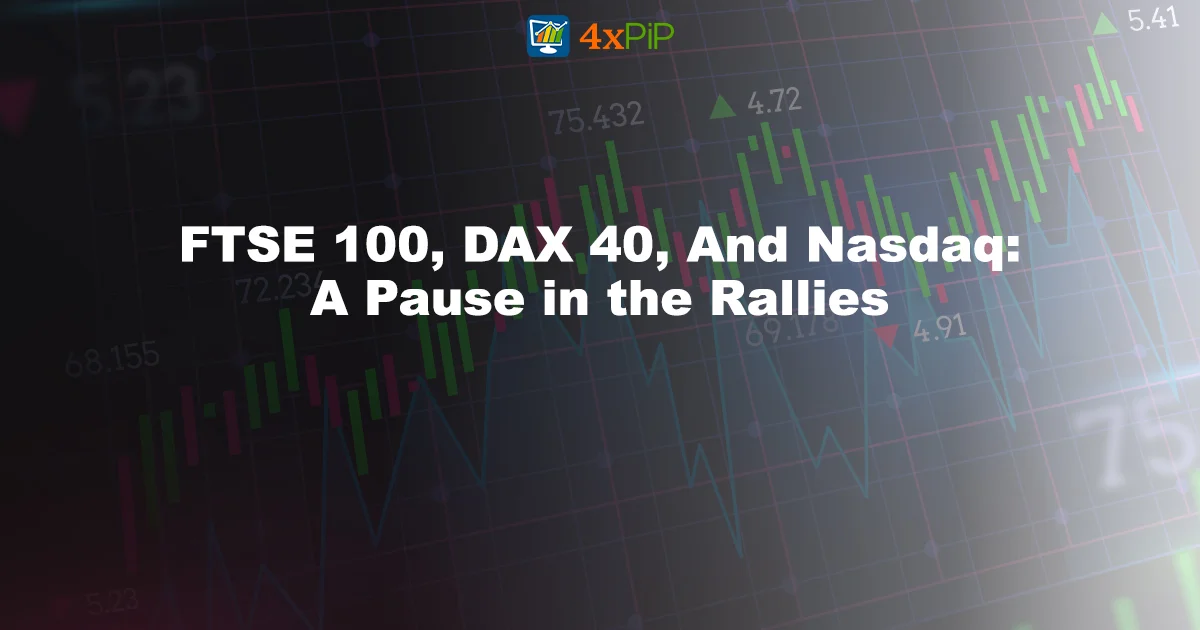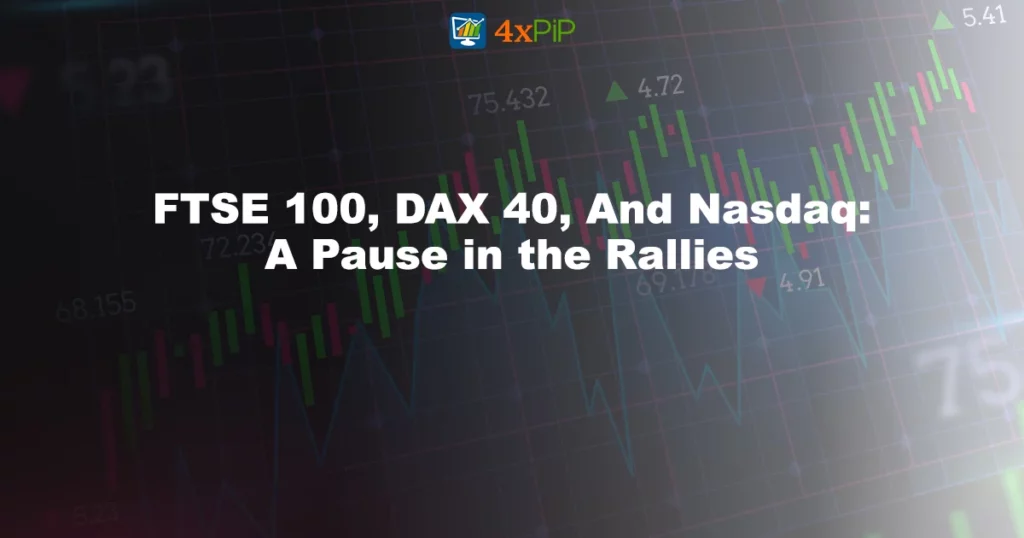As traders navigate the dynamic world of global indices, recent developments have painted a nuanced picture for key players such as the FTSE 100, DAX 40, and Nasdaq. In this blog, we dissect the latest movements, providing insights into the FTSE 100’s rally amidst softer inflation, the DAX 40’s impressive climb to a two-month high, and the Nasdaq 100’s approach to the July peak. Stay informed and adapt your strategies with 4xPip, your reliable source for trading tools. For expert guidance and a range of products, reach out to us at [email protected].
FTSE 100 Rallies on Softer Inflation in US and UK:
In a surprising turn of events, the FTSE 100 managed to stage a remarkable rally despite facing headwinds from softer inflation both in the United States and the United Kingdom. The initial setback was triggered by a combination of large-cap dividend payments and disappointing results from Burberry, causing the FTSE 100’s share price to plummet by over 10%. However, the index demonstrated resilience as it rebounded from Thursday’s low at 7,403.
An interesting aspect contributing to the FTSE 100’s bounce back was the softer inflation figures reported in both the US and the UK. Despite concerns about economic stability, the FTSE 100 not only recovered but also showed potential for further growth. The index’s ability to weather the storm amid these challenges speaks to the dynamism of the global markets and the intricate balance between economic indicators and market sentiment. As traders analyze these movements, it becomes crucial to stay vigilant and adapt strategies in response to the evolving landscape of economic data and corporate performance.
Looking ahead, traders should monitor key levels, including the 9 November high at 7,466, as potential targets for the FTSE 100. On the downside, the 7,430 low and support levels ranging from 7,384 to 7,369 provide critical reference points. This episode not only underscores the resilience of the FTSE 100 but also emphasizes the importance of understanding and navigating the intricate connections between economic factors and market behavior in today’s fast-paced financial landscape.
DAX 40 Reaches Two-Month High in Trading:
In a notable ascent, the DAX 40 has achieved an impressive feat by marking a two-month high in its recent trading activities. The index exhibited remarkable resilience, undergoing eight consecutive days of gains. Approaching levels not seen since August and September, specifically between 15,992 to 16,044, the DAX 40 encountered short-term resistance. This ascent signifies a positive momentum in the market, reflecting investor confidence and a potential bullish trend. However, traders should remain cautious as short-term resistance may pose challenges, and the index could face a temporary halt or correction.
Despite the recent highs, the DAX 40 has demonstrated stability with key support levels in place. Notably, the 200-day simple moving average at 15,661 provides a foundational support line. Additionally, further support can be identified along the early October high at 15,575 and the mid-September low at 15,561. These support levels act as crucial markers, offering traders insights into potential entry and exit points. The DAX 40’s ascent to a two-month high underscores the importance of monitoring both resistance and support levels for informed decision-making in the dynamic world of financial markets.
Nasdaq 100 Approaches July Peak of 15,932:
The Nasdaq 100, a tech powerhouse, is on the verge of reaching the crucial July peak at 15,932, following an impressive 12% rally from its late October low. Despite this upward momentum, a brief pause ensued due to profit-taking and a cautious outlook from retail giant Walmart, resulting in an 8% decline.
This peak at 15,932 acts as a significant hurdle for the index’s continued ascent. Traders closely monitor this level for potential breakthroughs or temporary reversals. While Thursday’s low at 15,736 provides immediate support, the uptrend line from October to November at 15,724 serves as a technical support level. Traders are also keeping a keen eye on the broader support zone between 15,628 to 15,520, representing the early to mid-September highs.
Navigating through this period of profit-taking, traders in the Nasdaq 100 should stay vigilant, making decisions informed by technical analysis and market dynamics, particularly around the critical 15,932 level.
Global Economic Factors Impacting Indices:
As we analyze the FTSE 100, DAX 40, and Nasdaq, it’s imperative to assess the broader economic forces steering these indices.
Inflationary Pressures:
FTSE 100: Its rally on softer inflation in the US and UK showcases sensitivity to inflation data, a critical indicator for market shifts.
DAX 40: Inflation concerns are evident in the DAX’s climb, reflecting global economic challenges and varying central bank strategies.
Nasdaq 100: The recent pause, partly due to inflation-related cautiousness, emphasizes the influence of inflation on tech-heavy indices.
Geopolitical Tensions:
FTSE 100: Trade disputes and political uncertainties impact the FTSE 100, requiring investors to monitor global events for potential disruptions.
DAX 40: As it reaches a two-month high, geopolitical tensions may introduce volatility, necessitating consideration in strategic decisions.
Nasdaq 100: Tech stocks in the Nasdaq 100 are sensitive to geopolitical tensions, demanding awareness of international relations.
Global Economic Indicators:
FTSE 100: Economic indicators from major economies, particularly the US and UK, impact the FTSE 100, guiding traders on market health.
DAX 40: Understanding global economic indicators is vital, given their influence on the German economy and the DAX’s performance.
Nasdaq 100: Global economic indicators shape the Nasdaq 100’s diverse tech companies, requiring traders to analyze macroeconomic trends.
Summary:
In this insightful exploration of market dynamics, we dissect recent movements in key indices – the FTSE 100, DAX 40, and Nasdaq. Despite initial setbacks, the FTSE 100 rallied on softer inflation, showcasing resilience amid economic challenges. The DAX 40’s impressive climb to a two-month high reflects positive momentum, emphasizing the importance of monitoring resistance and support levels. Meanwhile, the Nasdaq 100’s approach to the July peak brings attention to critical levels and the impact of global economic factors. As traders navigate these intricacies, staying informed is paramount. For a reliable source of trading tools, consult 4xPip at [email protected].












